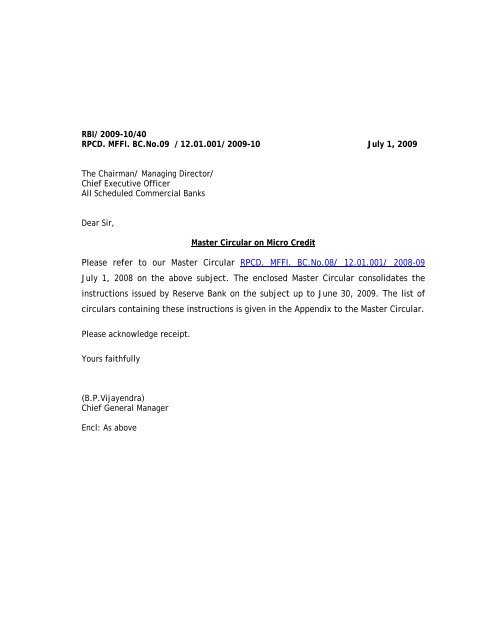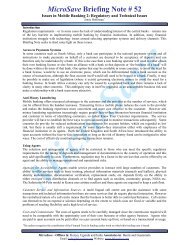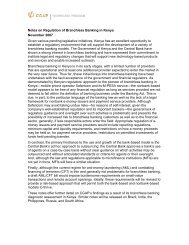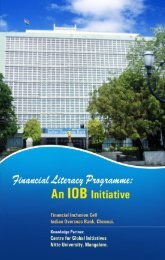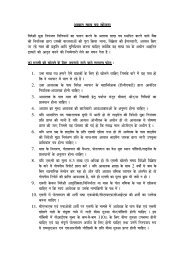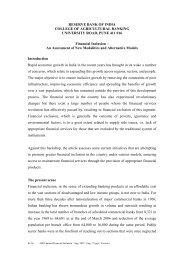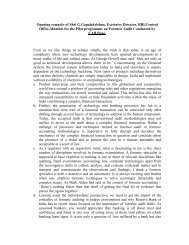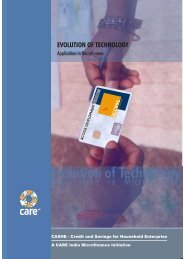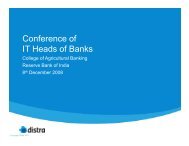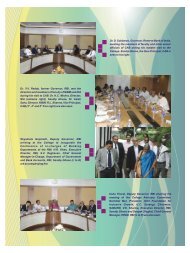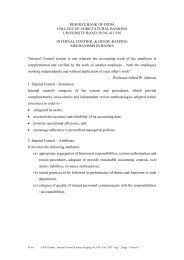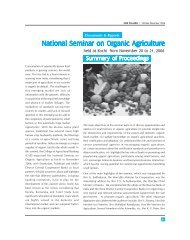Master Circular on Micro Credit - Reserve Bank of India
Master Circular on Micro Credit - Reserve Bank of India
Master Circular on Micro Credit - Reserve Bank of India
Create successful ePaper yourself
Turn your PDF publications into a flip-book with our unique Google optimized e-Paper software.
RBI/ 2009-10/40<br />
RPCD. MFFI. BC.No.09 / 12.01.001/ 2009-10 July 1, 2009<br />
The Chairman/ Managing Director/<br />
Chief Executive Officer<br />
All Scheduled Commercial <strong>Bank</strong>s<br />
Dear Sir,<br />
<str<strong>on</strong>g>Master</str<strong>on</strong>g> <str<strong>on</strong>g>Circular</str<strong>on</strong>g> <strong>on</strong> <strong>Micro</strong> <strong>Credit</strong><br />
Please refer to our <str<strong>on</strong>g>Master</str<strong>on</strong>g> <str<strong>on</strong>g>Circular</str<strong>on</strong>g> RPCD. MFFI. BC.No.08/ 12.01.001/ 2008-09<br />
July 1, 2008 <strong>on</strong> the above subject. The enclosed <str<strong>on</strong>g>Master</str<strong>on</strong>g> <str<strong>on</strong>g>Circular</str<strong>on</strong>g> c<strong>on</strong>solidates the<br />
instructi<strong>on</strong>s issued by <strong>Reserve</strong> <strong>Bank</strong> <strong>on</strong> the subject up to June 30, 2009. The list <strong>of</strong><br />
circulars c<strong>on</strong>taining these instructi<strong>on</strong>s is given in the Appendix to the <str<strong>on</strong>g>Master</str<strong>on</strong>g> <str<strong>on</strong>g>Circular</str<strong>on</strong>g>.<br />
Please acknowledge receipt.<br />
Yours faithfully<br />
(B.P.Vijayendra)<br />
Chief General Manager<br />
Encl: As above
<str<strong>on</strong>g>Master</str<strong>on</strong>g> <str<strong>on</strong>g>Circular</str<strong>on</strong>g> <strong>on</strong> <strong>Micro</strong> <strong>Credit</strong><br />
1. <strong>Micro</strong> <strong>Credit</strong><br />
<strong>Micro</strong> <strong>Credit</strong> has been defined as the provisi<strong>on</strong> <strong>of</strong> thrift, credit and other financial<br />
services and products <strong>of</strong> very small amount to the poor in rural, semi-urban and urban<br />
areas for enabling them to raise their income levels and improve their living standards.<br />
<strong>Micro</strong> <strong>Credit</strong> Instituti<strong>on</strong>s are those, which provide these facilities.<br />
2. The Self Help Group (SHG)- <strong>Bank</strong> Linkage Programme<br />
Despite the vast expansi<strong>on</strong> <strong>of</strong> the formal credit system in the country, the dependence <strong>of</strong><br />
the rural poor <strong>on</strong> m<strong>on</strong>eylenders c<strong>on</strong>tinues in many areas, especially for meeting<br />
emergent requirements. Such dependence is pr<strong>on</strong>ounced in the case <strong>of</strong> marginal farmers,<br />
landless labourers, petty traders and rural artisans bel<strong>on</strong>ging to socially and ec<strong>on</strong>omically<br />
backward classes and tribes whose propensity to save is limited or too small to be<br />
mopped up by the banks. For various reas<strong>on</strong>s, credit to these secti<strong>on</strong>s <strong>of</strong> the populati<strong>on</strong><br />
has not been instituti<strong>on</strong>alized. The studies c<strong>on</strong>ducted by NABARD, APRACA and ILO <strong>on</strong> the<br />
informal groups promoted by n<strong>on</strong> governmental organizati<strong>on</strong>s (NGOs) brought out that<br />
Self-Help Savings and <strong>Credit</strong> Groups have the potential to bring together the formal<br />
banking structure and the rural poor for mutual benefit and that their working has been<br />
encouraging.<br />
The NABARD accordingly launched a pilot project for the purpose and supported it by<br />
way <strong>of</strong> refinance. It also provided technical support and guidance to the agencies<br />
participating in the programme. The following criteria would broadly be adopted by<br />
NABARD for selecting SHGs:<br />
a) The Group should be in existence for at least six m<strong>on</strong>ths.<br />
b) The Group should have actively promoted the savings habit.<br />
c) Groups could be formal (registered) or informal (unregistered).<br />
d) Membership <strong>of</strong> the group could be between 10 to 25 pers<strong>on</strong>s.<br />
The advances given by the banks to the groups were treated as advances to "weaker<br />
secti<strong>on</strong>s" under the priority sector. While the norms relating to margin, security as also<br />
scales <strong>of</strong> finance and unit cost would broadly guide the banks for lending to the SHGs,<br />
deviati<strong>on</strong>s therefrom could be made by banks, where deemed necessary. These<br />
2
elaxati<strong>on</strong>s in margin, security norms, etc. were <strong>on</strong>ly in respect <strong>of</strong> SHGs to be financed<br />
under the pilot project.<br />
NABARD, vide its circular letter No.NB.DPD.FS.4631/92-A/91-92, dated 26 February,<br />
1992, issued detailed operati<strong>on</strong>al guidelines to banks for implementati<strong>on</strong> <strong>of</strong> the project.<br />
Quick studies c<strong>on</strong>ducted by NABARD in a few states to assess the impact <strong>of</strong> the linkage<br />
project brought out encouraging and positive features like increase in loan volume <strong>of</strong> the<br />
SHGS, definite shift in the loaning pattern <strong>of</strong> the members from n<strong>on</strong>-income generating<br />
activities to producti<strong>on</strong> activities, nearly 100% recovery performance, significant<br />
reducti<strong>on</strong> in the transacti<strong>on</strong> costs for both the banks and the borrowers, etc., besides<br />
leading to gradual increase in the income level <strong>of</strong> the SHG members. Another significant<br />
feature observed in the linkage project was that about 85% <strong>of</strong> the groups linked with the<br />
banks are formed exclusively by women.<br />
With a view to studying the functi<strong>on</strong>ing <strong>of</strong> SHGs and NGOs for expanding their activities<br />
and deepening their role in the rural sector, in November 1994, RBI c<strong>on</strong>stituted a<br />
Working Group comprising eminent NGO functi<strong>on</strong>aries, academicians, c<strong>on</strong>sultants and<br />
bankers under the Chairmanship <strong>of</strong> Shri S.K. Kalia, the then Managing Director, NABARD.<br />
As a follow up <strong>of</strong> the recommendati<strong>on</strong>s <strong>of</strong> the Working Group, banks were advised in April<br />
1996 as under:<br />
a) SHG Lending as Normal Lending Activity<br />
The SHGs linkage programme would be treated as a normal business activity <strong>of</strong> banks.<br />
Accordingly, the banks were advised that they may c<strong>on</strong>sider lending to SHGs as part <strong>of</strong><br />
their mainstream credit operati<strong>on</strong>s both at policy and implementati<strong>on</strong> level. They may<br />
include SHG linkage in their corporate strategy/plan, training curriculum <strong>of</strong> their <strong>of</strong>ficers<br />
and staff and implement it as a regular business activity and m<strong>on</strong>itor and review it<br />
periodically.<br />
b) Separate Segment under priority sector<br />
In order to enable the banks to report their SHG lending without difficulty, it was<br />
decided that the banks should report their lending to SHGs and/or to NGOs for <strong>on</strong>-lending<br />
to SHGs/members <strong>of</strong> SHGs/discrete individuals or small groups which are in the process<br />
<strong>of</strong> forming into SHGs under the new segment, viz. 'Advances to SHGs' irrespective <strong>of</strong> the<br />
3
purposes for which the members <strong>of</strong> SHGs have been disbursed loans. Lending to SHGs<br />
should be included by the banks as part <strong>of</strong> their lending to the weaker secti<strong>on</strong>s.<br />
c) Inclusi<strong>on</strong> in Service Area Approach<br />
<strong>Bank</strong>s may identify branches having potential for linkage and provide necessary support<br />
services to such branches and include SHG lending within their Service Area Plan.<br />
Keeping in view the potential realisability, the Service Area Branches may fix their own<br />
programme for lending to SHGs as in the case <strong>of</strong> other activities under the priority<br />
sector.<br />
With a view to enabling the bank branches to get the benefit <strong>of</strong> catalytic services <strong>of</strong><br />
NGOS, the names <strong>of</strong> NGOs dealing with the SHGs would be indicated <strong>on</strong> a block-wise basis<br />
in the "Background Paper for Service Area <strong>Credit</strong> Plans". The Service Area branch<br />
managers may have c<strong>on</strong>stant dialogue and rapport with the NGOs and SHGs <strong>of</strong> the area<br />
for effecting linkage. If a NGO/SHG feels more c<strong>on</strong>fident and assured to deal with a<br />
particular branch other than Service Area branch and the particular branch is willing to<br />
finance, such a NGO/SHG may, at its discreti<strong>on</strong>, deal with a branch other than the<br />
Service Area branch. The lending to SHGs by banks should be included in the LBR<br />
reporting system and reviewed, to start with at SLBC Level. However, it has to be borne<br />
in mind that the SHG linkage is a credit innovati<strong>on</strong> and not a targeted credit programme.<br />
d) Opening <strong>of</strong> Savings <strong>Bank</strong> A/c.<br />
The SHGs registered or unregistered which are engaged in promoting savings habits<br />
am<strong>on</strong>g their members would be eligible to open savings bank accounts with banks. These<br />
SHGs need not necessarily have already availed <strong>of</strong> credit facilities from banks before<br />
opening savings bank accounts.<br />
e) Margin and Security Norms<br />
As per operati<strong>on</strong>al guidelines <strong>of</strong> NABARD, SHGs are sancti<strong>on</strong>ed savings linked loans by<br />
banks (varying from a saving to loan ratio <strong>of</strong> 1:1 to 1:4). Experience showed that group<br />
dynamics and peer pressure brought in excellent recovery from members <strong>of</strong> the SHGS.<br />
<strong>Bank</strong>s were advised that the flexibility allowed to the banks in respect <strong>of</strong> margin,<br />
security norms, etc. under the pilot project would c<strong>on</strong>tinue to be operati<strong>on</strong>al under the<br />
linkage programme even bey<strong>on</strong>d the pilot phase.<br />
4
f) Documentati<strong>on</strong><br />
Keeping in view the nature <strong>of</strong> lending and status <strong>of</strong> borrowers, the banks may prescribe<br />
simple documentati<strong>on</strong> for lending to SHGs.<br />
g) Presence <strong>of</strong> defaulters in SHGs<br />
The defaults by a few members <strong>of</strong> SHGs and/or their family members to the financing<br />
bank should not ordinarily come in the way <strong>of</strong> financing SHGs per se by banks provided<br />
the SHG is not in default to it. However, the bank loan may not be utilized by the SHG<br />
for financing a defaulter member to the bank.<br />
h) Training<br />
An important step in the Linkage Programme would be the training <strong>of</strong> the field level<br />
<strong>of</strong>ficials and sensitizati<strong>on</strong> <strong>of</strong> the c<strong>on</strong>trolling and other senior <strong>of</strong>ficials <strong>of</strong> the bank.<br />
C<strong>on</strong>sidering the need and magnitude <strong>of</strong> training requirements <strong>of</strong> bank <strong>of</strong>ficers/staff both<br />
at field level and c<strong>on</strong>trolling <strong>of</strong>fice level, the banks may initiate suitable steps to<br />
internalize the SHGs linkage project and organize exclusive short durati<strong>on</strong> programmes<br />
for the field level functi<strong>on</strong>aries. In additi<strong>on</strong>, suitable awareness/sensitizati<strong>on</strong><br />
programmes may be c<strong>on</strong>ducted for their middle level c<strong>on</strong>trolling <strong>of</strong>ficers as well as senior<br />
<strong>of</strong>ficers.<br />
i) M<strong>on</strong>itoring and Review <strong>of</strong> SHG Lending<br />
Having regard to the emerging potential <strong>of</strong> the SHGs and the relative n<strong>on</strong>-familiarity <strong>of</strong><br />
the bank branches with lending to SHGS, banks may have to closely m<strong>on</strong>itor the progress<br />
regularly at various levels. Further the progress <strong>of</strong> the programme may be reviewed by<br />
the banks at regular intervals. A progress report may be sent to NABARD (<strong>Micro</strong> <strong>Credit</strong><br />
Innovati<strong>on</strong>s Department), Mumbai, in the format as per Annexure, <strong>on</strong> a half-yearly basis,<br />
as <strong>on</strong> 30 September and 31 March each year so as to reach within 30 days <strong>of</strong> the half-year<br />
to which the report relates.<br />
In order to give a boost to the <strong>on</strong> going SHG bank linkage programme for credit flow to<br />
the unorganised sector, banks were advised in January 2004 that m<strong>on</strong>itoring <strong>of</strong> SHG bank<br />
linkage programme may be made a regular item <strong>on</strong> the agenda for discussi<strong>on</strong> at the SLBC<br />
and DCC meetings.<br />
5
3. NBFCs engaged in micro-financing activities<br />
The Task Force <strong>on</strong> Supportive Policy and Regulatory Framework for <strong>Micro</strong>finance set up<br />
by NABARD in 1999 recommended that the policy and regulatory framework should give a<br />
fillip to the Self Help Groups (SHGs) or N<strong>on</strong>-Governmental Organisati<strong>on</strong>s (NGOs) engaged<br />
in micro-financing activities. Accordingly, it was decided to exempt such NBFCs which<br />
are engaged in (i) micro financing activities, (ii) licensed under Secti<strong>on</strong> 25 <strong>of</strong> the<br />
Companies Act, 1956 and (iii) which are not accepting public deposits from the purview<br />
<strong>of</strong> Secti<strong>on</strong>s 45-IA (registrati<strong>on</strong>), 45-IB (maintenance <strong>of</strong> liquid assets) and 45-IC (transfer<br />
<strong>of</strong> pr<strong>of</strong>its to <strong>Reserve</strong> Fund) <strong>of</strong> the RBI Act, 1934.<br />
Based <strong>on</strong> the recommendati<strong>on</strong>s <strong>of</strong> the Advisory Committee <strong>on</strong> Flow <strong>of</strong> <strong>Credit</strong> to<br />
Agriculture and Related Activities from the <strong>Bank</strong>ing System (Vyas Committee), in the<br />
Annual Policy Statement for the year 2004-05, it has been announced that, in view <strong>of</strong> the<br />
need to protect the interests <strong>of</strong> depositors, micr<strong>of</strong>inance instituti<strong>on</strong>s (MFIs) would not be<br />
permitted to accept public deposits unless they comply with the extant regulatory<br />
framework <strong>of</strong> the <strong>Reserve</strong> <strong>Bank</strong>.<br />
4. Interest rates<br />
The interest rate applicable to loans given by banks to micro-credit organisati<strong>on</strong>s or by<br />
the micro-credit organisati<strong>on</strong>s to Self Help Groups/member beneficiaries would be left to<br />
their discreti<strong>on</strong>.<br />
5. Mainstreaming and enhancing outreach<br />
A <strong>Micro</strong> <strong>Credit</strong> Special Cell was set up in RBI to suggest measures for augmenting flow <strong>of</strong><br />
micro credit as announced in Governor’s M<strong>on</strong>etary and <strong>Credit</strong> Policy for the year 1999-<br />
2000. In the meantime, a Task Force <strong>on</strong> Supportive Policy and Regulatory Framework for<br />
<strong>Micro</strong> <strong>Credit</strong> was also set up by NABARD. On the basis <strong>of</strong> their recommendati<strong>on</strong>s, banks<br />
were advised to follow the under noted guidelines for mainstreaming micro credit and<br />
enhancing the outreach <strong>of</strong> micro credit providers:<br />
(i)<br />
The banks may formulate their own model(s) or choose any c<strong>on</strong>duit/<br />
intermediary for extending micro credit. They may choose suitable<br />
branches/pockets/areas where micro credit programmes can be<br />
implemented. It will be useful to start with a selected small area and<br />
6
(ii)<br />
(iii)<br />
(iv)<br />
(v)<br />
c<strong>on</strong>centrate fully <strong>on</strong> the poor in that area and thereafter with the experience<br />
gained replicate the arrangement in other selected areas. <strong>Micro</strong> <strong>Credit</strong><br />
extended by banks to individual borrowers directly or through any<br />
intermediary would be reck<strong>on</strong>ed as part <strong>of</strong> their priority sector lending.<br />
The criteria for selecti<strong>on</strong> <strong>of</strong> micro credit organisati<strong>on</strong>s are not prescribed. It<br />
may, however, be desirable for banks to deal with micro credit organisati<strong>on</strong>s<br />
having proper credentials, track record, system <strong>of</strong> maintaining accounts and<br />
records with regular audits in place and manpower for closer supervisi<strong>on</strong> and<br />
follow-up.<br />
<strong>Bank</strong>s may prescribe their own lending norms keeping in view the ground<br />
realities. They may devise appropriate loan and savings products and the<br />
related terms and c<strong>on</strong>diti<strong>on</strong>s including the size <strong>of</strong> the loan, unit cost, unit<br />
size, maturity period, grace period, margins, etc. The intenti<strong>on</strong> is to provide<br />
maximum flexibility in regard to micro lending, keeping in view the prevalent<br />
local c<strong>on</strong>diti<strong>on</strong>s and the need for provisi<strong>on</strong> <strong>of</strong> finance to the poor. Such credit<br />
should, therefore, cover not <strong>on</strong>ly c<strong>on</strong>sumpti<strong>on</strong> and producti<strong>on</strong> loans for<br />
various farm and n<strong>on</strong>-farm activities <strong>of</strong> the poor but also include their other<br />
credit needs such as housing and shelter improvements.<br />
<strong>Micro</strong> credit should be included in branch credit plan, block credit plan and<br />
state credit plan <strong>of</strong> each bank. While no target is being prescribed for micro<br />
credit, utmost priority is to be accorded to the micro credit sector in<br />
preparati<strong>on</strong> <strong>of</strong> these plans. <strong>Micro</strong> credit should also form an integral part <strong>of</strong><br />
the bank's corporate credit plan and should be reviewed at the highest level<br />
<strong>on</strong> a quarterly basis.<br />
A simple system requiring minimum procedures and documentati<strong>on</strong> is a prec<strong>on</strong>diti<strong>on</strong><br />
for augmenting flow <strong>of</strong> micro credit. Hence, banks should strive to<br />
remove all operati<strong>on</strong>al irritants and make arrangements to expeditiously<br />
sancti<strong>on</strong> and disburse micro credit by delegating adequate sancti<strong>on</strong>ing powers<br />
to branch managers. The loan applicati<strong>on</strong> forms, procedures and documents<br />
should be made simple which would help in providing prompt and hassle-free<br />
micro credit.<br />
7
6. Delivery Issues<br />
The <strong>Reserve</strong> <strong>Bank</strong> c<strong>on</strong>stituted four informal groups in October 2002 to examine various<br />
issues c<strong>on</strong>cerning micro-finance delivery. On the basis <strong>of</strong> the recommendati<strong>on</strong>s <strong>of</strong> the<br />
groups and as announced in Paragraph 55 <strong>of</strong> the Governor’s Statement <strong>on</strong> mid-term<br />
Review <strong>of</strong> the M<strong>on</strong>etary and <strong>Credit</strong> Policy for the year 2003-04, banks have been advised<br />
as under:<br />
(i)<br />
(ii)<br />
(iii)<br />
<strong>Bank</strong>s should provide adequate incentives to their branches in financing the<br />
Self Help Groups (SHGs) and establish linkages with them, making the<br />
procedures absolutely simple and easy while providing for total flexibility in<br />
such procedures to suit local c<strong>on</strong>diti<strong>on</strong>s.<br />
The group dynamics <strong>of</strong> working <strong>of</strong> the SHGs may be left to themselves and<br />
need neither be regulated nor formal structures imposed or insisted up<strong>on</strong>.<br />
The approach to micro-financing <strong>of</strong> SHGs should be totally hassle-free and<br />
may include c<strong>on</strong>sumpti<strong>on</strong> expenditures.<br />
7. Financing <strong>of</strong> MFIs by banks<br />
A joint fact-finding study <strong>on</strong> micr<strong>of</strong>inance c<strong>on</strong>ducted by <strong>Reserve</strong> <strong>Bank</strong> and a few major<br />
banks made the following observati<strong>on</strong>s:<br />
(i)<br />
Some <strong>of</strong> the micr<strong>of</strong>inance instituti<strong>on</strong>s (MFIs) financed by banks or acting as<br />
their intermediaries/partners appear to be focussing <strong>on</strong> relatively better<br />
banked areas, including areas covered by the SHG-<strong>Bank</strong> linkage programme.<br />
Competing MFIs were operating in the same area, and trying to reach out to<br />
the same set <strong>of</strong> poor, resulting in multiple lending and overburdening <strong>of</strong> rural<br />
households.<br />
(ii)<br />
Many MFIs supported by banks were not engaging themselves in capacity<br />
building and empowerment <strong>of</strong> the groups to the desired extent. The MFIs<br />
were disbursing loans to the newly formed groups within 10-15 days <strong>of</strong> their<br />
formati<strong>on</strong>, in c<strong>on</strong>trast to the practice obtaining in the SHG - <strong>Bank</strong> linkage<br />
programme which takes about 6-7 m<strong>on</strong>ths for group formati<strong>on</strong> / nurturing /<br />
handholding. As a result, cohesiveness and a sense <strong>of</strong> purpose were not being<br />
built up in the groups formed by these MFIs.<br />
8
(iii)<br />
<strong>Bank</strong>s, as principal financiers <strong>of</strong> MFIs, do not appear to be engaging them with<br />
regard to their systems, practices and lending policies with a view to ensuring<br />
better transparency and adherence to best practices. In many cases, no<br />
review <strong>of</strong> MFI operati<strong>on</strong>s was undertaken after sancti<strong>on</strong>ing the credit facility.<br />
These findings were brought to the notice <strong>of</strong> the banks to enable them to take necessary<br />
corrective acti<strong>on</strong> where required.<br />
8. Total Financial Inclusi<strong>on</strong> and <strong>Credit</strong> Requirement <strong>of</strong> SHGs<br />
Attenti<strong>on</strong> is invited to Paragraph 93 <strong>of</strong> the Uni<strong>on</strong> Budget announcement made by the<br />
H<strong>on</strong>ourable Finance Minister for the year 2008-09 where in it has been stated as under:<br />
"<strong>Bank</strong>s will be encouraged to embrace the c<strong>on</strong>cept <strong>of</strong> Total Financial Inclusi<strong>on</strong>.<br />
Government will request all scheduled commercial banks to follow the example set<br />
by some public sector banks and meet the entire credit requirements <strong>of</strong> SHG<br />
members, namely, (a) income generati<strong>on</strong> activities, (b) social needs like housing,<br />
educati<strong>on</strong>, marriage, etc. and (c) debt swapping".<br />
<strong>Bank</strong>s are advised to meet the entire credit requirements <strong>of</strong> SHG members, as envisaged<br />
therein.<br />
9
Sr.<br />
No.<br />
Appendix<br />
List <strong>of</strong> <str<strong>on</strong>g>Circular</str<strong>on</strong>g>s c<strong>on</strong>solidated in the <str<strong>on</strong>g>Master</str<strong>on</strong>g> <str<strong>on</strong>g>Circular</str<strong>on</strong>g><br />
<str<strong>on</strong>g>Circular</str<strong>on</strong>g> No. Date Subject<br />
1. RPCD.No.Plan.BC.13/PL-09.22/91/92 July 24, 1991 Improving Access <strong>of</strong> Rural<br />
Poor to <strong>Bank</strong>ing -<br />
Role <strong>of</strong> Intervening Agencies -<br />
Self Help Groups<br />
2. RPCD.No.PL.BC.120/04.09.22/95-96 April 2, 1996 Linking <strong>of</strong> Self Help Groups<br />
with <strong>Bank</strong>s- Working Group <strong>on</strong><br />
NGOs and SHGs-<br />
Recommendati<strong>on</strong>s-Follow up<br />
3 DBOD.No.DIR.BC.11/13.01.08/98 February 10,<br />
1998<br />
Opening <strong>of</strong> savings bank<br />
accounts in the name <strong>of</strong> Self<br />
Help Groups (SHGs)<br />
4 RPCD.No.PL.BC.12/04.09.22/98-99 July 24,1998 Linking <strong>of</strong> Self Help Groups<br />
with <strong>Bank</strong>s<br />
5 RPCD.No.PLAN.BC.94/04.09.01/98-99 April 24,1999 Loans to <strong>Micro</strong> credit<br />
Organizati<strong>on</strong>s- Rates <strong>of</strong><br />
Interest<br />
6 RPCD.PL.BC.28/04.09.22/99-2000 September 30,<br />
1999<br />
7 DNBS. (PD). CC.No.12/02.01/99-2000 January 13,<br />
2000<br />
8 RPCD.No.PL.BC.62/04.09.01/99-2000 February 18,<br />
2000<br />
9 RPCD. No. Plan.BC.42/04.09.22/2003-04 November 3,<br />
2003<br />
<strong>Credit</strong> Delivery through <strong>Micro</strong><br />
<strong>Credit</strong> Organizati<strong>on</strong>s/Self Help<br />
Groups<br />
Amendments to NBFC<br />
Regulati<strong>on</strong>s<br />
<strong>Micro</strong> <strong>Credit</strong><br />
<strong>Micro</strong> finance<br />
10 RPCD.No.Plan.BC.61/04.09.22/2003-04 January 9, 2004 <strong>Credit</strong> flow to unorganized<br />
sector<br />
11 RBI/385/2004-05,<br />
RPCD.No.Plan.BC.84/04.09.22/2004-05<br />
12 RBI 2006-07/185<br />
RPCD.CO.Plan. BC. No.34/ 04.09.22/ 2006-<br />
07<br />
13 RBI/2006-07/441<br />
RPCD.CO.MFFI.BC.No.103/12.01.01/2006-07<br />
14 RBI/282/2007-08<br />
RPCD.MFFI.BC.No.56/12.01.001/2007-08<br />
March 3, 2005 Submitting progress report<br />
under micro credit<br />
November 22,<br />
2006<br />
<strong>Micro</strong>finance - Joint factfinding<br />
study with the banks<br />
June 20, 2007 <strong>Micro</strong>finance-Submissi<strong>on</strong> <strong>of</strong><br />
progress reports<br />
April 15, 2008<br />
Total Financial Inclusi<strong>on</strong> and<br />
<strong>Credit</strong> Requirement <strong>of</strong> SHGs<br />
10
Annexure<br />
<strong>Micro</strong> Finance Progress Report<br />
As at the end <strong>of</strong> March/ Sept.<br />
Name <strong>of</strong> the bank State<br />
Part 'A' – SHG <strong>Bank</strong> Linkage Program (All amounts in Rs. '000)<br />
1. SHGs maintaining Savings A/c in the <strong>Bank</strong><br />
a. Total no. <strong>of</strong> SHGs<br />
b. Of which under SGSY & other Govt. sp<strong>on</strong>sored schemes<br />
c. Exclusive Women SHGs [Out <strong>of</strong> (a) above]<br />
d. Of which under SGSY & other Govt. sp<strong>on</strong>sored schemes<br />
No. <strong>of</strong> SHGs No. <strong>of</strong><br />
Members<br />
Savings Amount<br />
i
Part 'A' – SHG <strong>Bank</strong> Linkage Program<br />
2. SHGs financed directly by <strong>Bank</strong>s<br />
Total no. <strong>of</strong> SHGs<br />
(All amounts in Rs. '000)<br />
During the year Loan outstanding Gross NPAs**<br />
Percentage <strong>of</strong><br />
Loan Amount No. <strong>of</strong> No. <strong>of</strong> Amount No. <strong>of</strong> SHGs Amount No.<strong>of</strong> SHGs Recovery to<br />
Disbursed SHGs Members<br />
with NPAs Demand<br />
(b) Of which<br />
under SGSY & other<br />
Govt. sp<strong>on</strong>sored<br />
Programs<br />
Exclusive<br />
SHGs<br />
Women<br />
(b) Of which<br />
under SGSY & other<br />
Govt. sp<strong>on</strong>sored<br />
Programs<br />
**Applicable to March return <strong>on</strong>ly.<br />
ii
Part 'A' – SHG <strong>Bank</strong> Linkage Program<br />
3. SHGs financed directly by <strong>Bank</strong>s with NGOs' facilitati<strong>on</strong><br />
Total no. <strong>of</strong> SHGs<br />
(All amounts in Rs. '000)<br />
During the year Loan outstanding Gross NPAs**<br />
Percentage <strong>of</strong><br />
Loan Amount No. <strong>of</strong> No. <strong>of</strong> Amount No. <strong>of</strong> SHGs Amount No.<strong>of</strong> SHGs Recovery to<br />
Disbursed SHGs members<br />
with NPAs Demand<br />
(b) Of which<br />
under SGSY & other<br />
Govt. sp<strong>on</strong>sored<br />
Programs<br />
Exclusive<br />
SHGs<br />
Women<br />
(b) Of which<br />
under SGSY & other<br />
Govt. sp<strong>on</strong>sored<br />
Programs<br />
**Applicable to March return <strong>on</strong>ly.<br />
iii
Part 'B' : MFOs / MFIs - <strong>Bank</strong> Linkage for <strong>on</strong>-lending to groups and others<br />
MFOs/ MFIs maintaining Savings A/c in the <strong>Bank</strong><br />
S. No. Nature <strong>of</strong> Intermediary No. <strong>of</strong><br />
MFIs/ MFOs<br />
1. NGO MFOs – Societies Registrati<strong>on</strong> Act 1860 and<br />
<strong>India</strong>n Trust Act 1880<br />
2. Cooperative MFOs- Cooperative Societies Act <strong>of</strong><br />
each State<br />
3. Cooperative MFOs- Mutually Aided Cooperative<br />
Societies Act (MACS)<br />
4. Cooperative MFOs- Multi State Coop. Societies Act<br />
2002<br />
5. NBFC MFIs under Secti<strong>on</strong> 25 <strong>of</strong> Companies Act 1956<br />
(Not for pr<strong>of</strong>it)<br />
6. NBFC MFIs incorporated under Companies Act 1956<br />
& registered with RBI<br />
7. Others (To be specified)<br />
Total<br />
(All amounts in Rs. '000)<br />
Savings Amount<br />
iv
Part 'B' : MFOs / MFIs- bank Linkage for <strong>on</strong>-lending to groups and others<br />
2. MFOs/ MFIs financed by the <strong>Bank</strong><br />
S.<br />
No.<br />
Nature <strong>of</strong> Intermediary<br />
1. NGO MFOs – Societies<br />
Registrati<strong>on</strong> Act 1860 and<br />
<strong>India</strong>n Trust Act 1880<br />
2. Cooperative MFOs-<br />
Cooperative Societies Act <strong>of</strong><br />
each State<br />
3. Cooperative MFOs- Mutually<br />
Aided Cooperative Societies<br />
Act (MACS)<br />
4. Cooperative MFOs- Multi<br />
State Coop. Societies Act<br />
2002<br />
5. NBFC MFIs under Secti<strong>on</strong> 25<br />
<strong>of</strong> Companies Act 1956 (Not<br />
for pr<strong>of</strong>it)<br />
6. NBFC MFIs incorporated<br />
under Companies Act 1956 &<br />
registered with RBI<br />
7. Others (To be specified)<br />
SHG Model<br />
N<strong>on</strong>-SHG Model<br />
SHG Model<br />
N<strong>on</strong>-SHG Model<br />
SHG Model<br />
N<strong>on</strong>-SHG Model<br />
SHG Model<br />
N<strong>on</strong>-SHG Model<br />
SHG Model<br />
N<strong>on</strong>-SHG Model<br />
SHG Model<br />
N<strong>on</strong>-SHG Model<br />
SHG Model<br />
N<strong>on</strong>-SHG Model<br />
During the year<br />
Loan<br />
disburse<br />
d<br />
No. <strong>of</strong><br />
MFOs/M<br />
FIs<br />
Loan outstanding<br />
Amount<br />
No. <strong>of</strong><br />
MFIs<br />
having<br />
O/S loans<br />
Percentage<br />
<strong>of</strong><br />
Recovery<br />
to Demand<br />
(All amounts in Rs. '000)<br />
Gross NPAs**<br />
No. <strong>of</strong> MFOs/<br />
Amount MFIs with<br />
NPAs<br />
Total<br />
SHG Model<br />
N<strong>on</strong>-SHG Model<br />
**Applicable to March return <strong>on</strong>ly<br />
v


